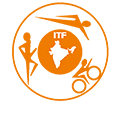ABOUT PARATRIATHLON

Para triathlon is a multidisciplinary endurance sport that challenges athletes to a continuous race over three disciplines: swim, cycle and run. Competition categories are based on types of impairment both physical and visual. Depending on the category, athletes may use a handcycle, tandem bicycle or bicycle on the bike course, while wheelchairs are permitted on the run section. Indian para triathletes have the opportunity each year to be selected to compete for India at the World Triathlon – World Championships. Para triathlon is part of Para Olympics and Para Commonwealth Games. Indian Triathlon Federation is affiliated to Para Olympics committee of India.
EVENTS/DISCIPLINES
Sprint Distance Triathlon - 750m swim, 20km bike, 5km run. (individual and team entry options)
CLASSIFICATIONS
- Who is eligible for Para triathlon?
Athletes with a vision impairment or physical impairment - Classification of athletes
Classification provides a structure for competition. Athletes competing in para-sports have an impairment that leads to a competitive disadvantage. Consequently, a system has to be put in place to minimise the impact of impairments on sport performance and to ensure the success of an athlete is determined by skill, fitness, power, endurance, tactical ability and mental focus. This system is called classification. Classification determines who is eligible to compete in a para-sport and it groups the eligible athletes in sport classes according to their activity limitation in a certain sport. - What are the classes?
A sport class is a category which groups athletes depending on how much their impairment impacts performance in their sport. Therefore, a sport class is not necessarily comprised of one impairment type alone, but can be comprised of athletes with different impairments.
THERE ARE NINE SPORT CLASSES IN PARATRIATHLON:
- PTWC1 - Most impaired wheelchair users. Athletes must use a recumbent handcycle on the bike course and a racing wheelchair on the run segment; Includes athletes with comparable activity limitation and an impairment of, but not limited to: muscle power, limb deficiency, hypertonia, ataxia or athetosis.
- PTWC2 - Least impaired wheelchair users. Athletes must use a recumbent handcycle on the bike course and a racing wheelchair on the run segment; Includes athletes with comparable activity limitation and an impairment of, but not limited to: muscle power, limb deficiency, hypertonia, ataxia or athetosis.
- PTS2 - Severe impairments. In both bike and run segments, amputee athletes may use approved prosthesis or other supportive devices. Includes athletes with comparable activity limitation and an impairment of, but not limited to, limb deficiency, hypertonia, ataxia and or athetosis, impaired muscle power or range of movement.
- PTS3 - Significant impairments. In both bike and run segments, amputee athletes may use approved prosthesis or other supportive devices. Includes athletes with comparable activity limitation and an impairment of, but not limited to, limb deficiency, hypertonia, ataxia and or athetosis, impaired muscle power or range of movement.
- PTS4 - Moderate impairments. In both bike and run segments, amputee athletes may use approved prosthesis or other supportive devices. Includes athletes with comparable activity limitation and an impairment of, but not limited to, limb deficiency, hypertonia, ataxia and or athetosis, impaired muscle power or range of movement.
- PTS5 - Mild impairments. In both bike and run segments, amputee athletes may use approved prosthesis or other supportive devices. Includes athletes with comparable activity limitation and an impairment of, but not limited to, limb deficiency, hypertonia, ataxia and or athetosis, impaired muscle power or range of movement..
- PTVI1 - Includes athletes who are totally blind, from no light perception in either eye, to some light perception. One guide is mandatory throughout the race. Must ride a tandem during the bike segment. A guide from the same nationality and gender is mandatory throughout the race. Must ride a tandem during the bike segment.
- PTVI2 - Includes athletes who are more severe partially sighted athletes. One guide is mandatory throughout the race. Must ride a tandem during the bike segment. A guide from the same nationality and gender is mandatory throughout the race. Must ride a tandem during the bike segment.
- PTVI3 - Includes athletes who are less severe partially sighted athletes. One guide is mandatory throughout the race. Must ride a tandem during the bike segment. A guide from the same nationality and gender is mandatory throughout the race. Must ride a tandem during the bike segment.
- Both PTWC1 and PTWC2 classes compete in the same PTWC Medal Event. All the ambulant classes (PTS2-PTS5) compete in their own medal event and the three visual impaired classes (PTVI1, PTVI2 and PTVI3) compete into the PTVI medal event.
- Please visit the World Triathlon to find out more about the classification process- https://www.triathlon.org/about/downloads_category/paratriathlon
HOW DO I GET A CLASSIFICATION ?
- Contact indiantriathlonfederation@gmail.com or harish@triathlonindia.com for more queries.
